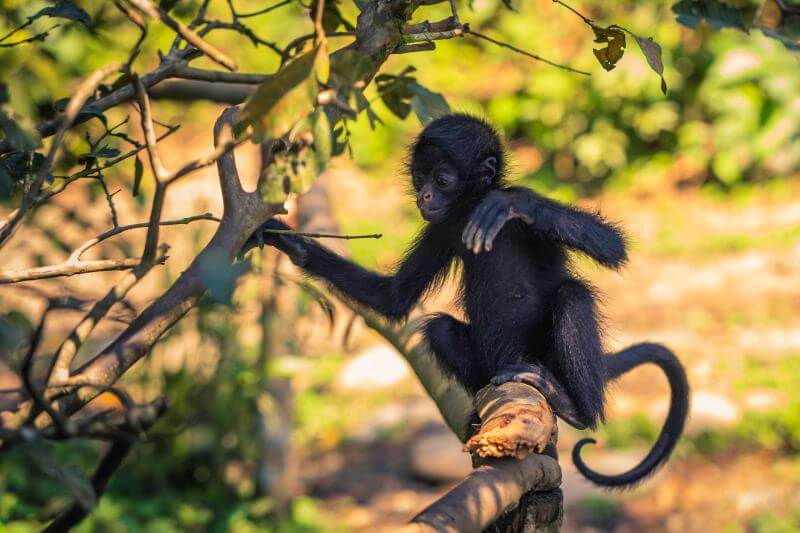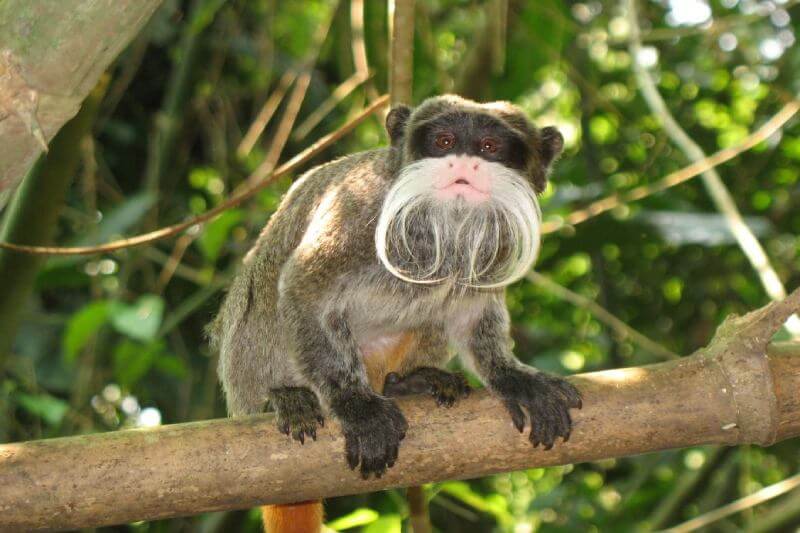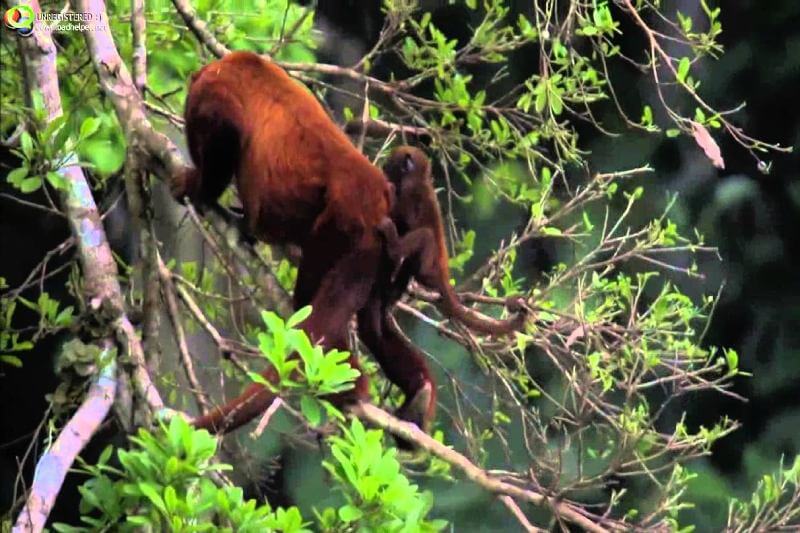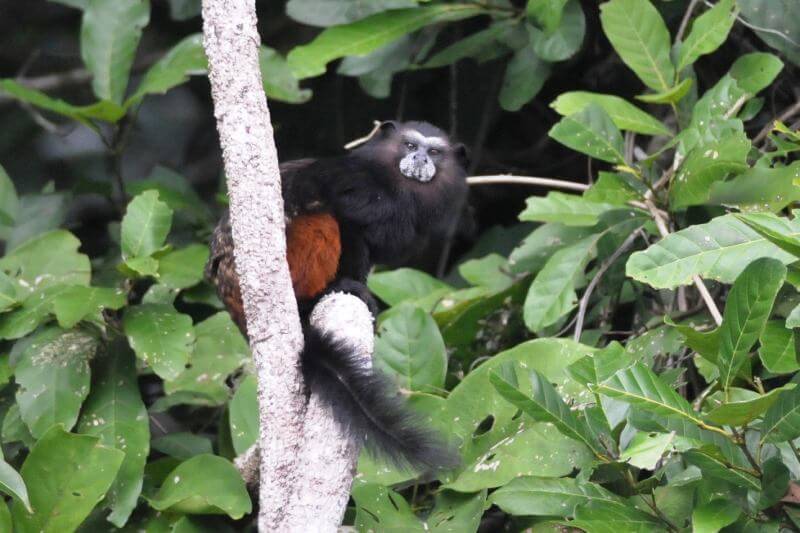Manu National Park is a haven for biodiversity. Among its residents are various primates that capture the curiosity of visitors. The monkeys of Manu are fascinating. This guide offers an in-depth look at these primates.
From the treetops to the forest floor, monkeys are integral to the park’s ecosystem. They vary in size, behavior, and habitat. Understanding them enhances our visits significantly.
Our comprehensive guide will introduce you to the fascinating world of Manu’s monkeys. We’ll explore species, behaviors, and conservation efforts. Prepare to be amazed by their diversity.
Whether you’re a wildlife enthusiast or planning a visit, this guide is invaluable. It promises insights into the lives of these intriguing animals. Let’s embark on this journey together.
This protected area serves as a sanctuary for numerous species of primates. Each species plays a crucial role in the ecosystem, from dispersing seeds to maintaining the balance of forest dynamics. The park’s commitment to conservation ensures these primates thrive in their natural habitat.
Visitors often marvel at the sight of spider monkeys swinging through the treetops. Their agility and social structures fascinate scientists and tourists alike. These primates embody the spirit of the Amazon, showcasing the adaptability of species in this rich environment.
Howler monkeys, with their distinct calls, echo throughout the forests of Manu. They signal the start of a new day and play a key role in the life of the rainforest. Their calls, a part of the park’s unique soundscape, remind us of the complexity of these ecosystems.
The lowland rainforest and oxbow lakes of Manu also provide critical habitats for these primates. These areas, rich in plants and animals, offer abundant food and shelter. Monkeys of Manu rely on these environments to survive and flourish.

In the heart of the Amazon, the monkeys of Manu contribute significantly to the health of their habitat. By feeding on fruits and nuts, they disperse seeds across vast distances. This activity promotes forest regeneration and diversity, highlighting their role as keystone species.
The cloud forests, part of the park’s higher elevations, present a different setting for primate life. Here, the moisture-rich air supports a different array of plants and animals. Monkeys in these areas have adapted to cooler temperatures and denser foliage.
Observing these primates, researchers and visitors gain insights into the interconnectedness of life in Manu. The monkeys’ behaviors, from feeding to social interactions, reflect the complexity of their relationships with the environment. They not only depend on the forest but also shape it.
The species of monkeys in Manu National Park vary widely, each with unique traits and habits. From the nimble tamarin to the majestic howler, the park’s primate population is a testament to evolutionary adaptability. These species embody the essence of the Peruvian Amazon’s wildlife.
The Manu Reserved Zone, a less accessible part of the park, harbors top predators and rare primates. Expeditions into this area often reveal the elusive nature of some monkey species. Their sightings contribute to our understanding of biodiversity and the importance of protected areas.
Species of birds, such as the iconic cocks of the rock, share the habitat with monkeys. This coexistence underscores the park’s role as a haven for wildlife. The diversity of life here is a vivid example of the Amazon’s ecological richness.
Conserving the monkeys of Manu and their habitat faces ongoing challenges. Human activities, including deforestation and illegal hunting, threaten the balance of these ecosystems. The park’s status as a protected area is crucial in the fight against these pressures.
Conservation efforts focus on research, monitoring, and community engagement. By understanding the needs and behaviors of the monkeys of Manu, scientists can develop strategies to protect them. Engaging local communities ensures that conservation benefits both wildlife and people.
The clay licks and oxbow lakes in Manu offer unique opportunities for conservation education. These sites attract not only primates but also tourists and researchers. They serve as natural laboratories for studying wildlife and ecosystem dynamics.
We embark to explore monkeys in Manu National Park. These primates, with their varied lifestyles and adaptations, remind us of nature’s resilience and beauty. Protecting them and their home is a shared responsibility.
The future of the monkeys of Manu and the Amazon rainforest depends on our actions today. Conservation is not just about preserving species; it’s about ensuring the health of our planet. As we learn from and about these remarkable primates, we become stewards of their legacy.

Manu National Park, nestled in the heart of the Peruvian Amazon, is a sanctuary for biodiversity. Among its most fascinating inhabitants are the monkeys of Manu. These primates offer a window into the complex social structures and behaviors that thrive in the Amazon rainforest. In this blog post, we delve into the social lives of Manu’s monkeys.
Monkeys of Manu form intricate social hierarchies that dictate their interactions. Species like the howler monkeys are famous for their loud calls, which help maintain group cohesion and territorial boundaries. These vocalizations are not just mere sounds; they are complex communications. They can convey information about food, danger, and social status.
In groups, there is often a dominant male or female that leads. This leadership is crucial for navigating the challenges of the rainforest, from finding food to avoiding predators. The structure of these groups ensures that the monkeys maximize their survival.
Monkeys of Manu exhibit a fascinating balance between cooperation and competition. For instance, spider monkeys, with their long, agile limbs, are adept at foraging for fruits and nuts. They often spread out to gather food but will communicate the location of a rich food source to others. This behavior demonstrates an understanding of group benefit over individual gain.
However, competition is also a part of their world. Food scarcity can lead to conflicts, especially in areas where resources are not abundant. These moments of competition are critical, as they teach younger monkeys important survival skills.
While vocal calls are the main communication among the monkeys of Manu. Monkeys also use facial expressions and body language. The subtlety of a gesture or the positioning of a tail can convey as much information as a howl or a screech. This non-verbal communication is essential for maintaining social order and expressing emotions within the group.
Parenting is another aspect where the social lives of Manu’s monkeys shine. Many species exhibit remarkable care for their young. Mothers and other group members participating in nurturing and protection.
This communal approach ensures that the young ones receive the attention they need to thrive. The group also develops as a unity.
Play is an integral part of life for the younger monkeys. Through play, they learn vital skills such as foraging, escaping predators, and social interaction. These playful interactions are not just amusing to observe but are crucial for the development of the monkeys.

The monkeys of Manu play a pivotal role in the ecosystem of the Amazon rainforest. Through their daily activities, they contribute to seed dispersal, aiding in the regeneration of the forest. Their interactions with plants and animals are a testament to the interconnectedness of life in Manu National Park.
The protected area of Manu ensures that these complex behaviors and interactions continue to thrive. Conservation efforts in the park protect countless other species of mammals, birds, and plants.
Despite the protected status of Manu National Park, the monkeys face challenges. Deforestation and climate change threaten their habitats, while illegal hunting poses a direct threat to their populations. Conservation initiatives focus on protecting these primates and their environment, ensuring that the Amazon rainforest remains a vibrant, thriving ecosystem.
Understanding the social lives of Manu’s monkeys is not just an academic exercise. It is a journey into the heart of the Amazon, revealing the complex tapestry of life that exists within. These insights underscore the importance of conservation efforts.
Manu National Park, a jewel in the Peruvian Amazon, is home to an incredible diversity of life. Among its inhabitants, the monkeys of Manu stand out, playing crucial roles in the ecosystem. However, protecting these primates poses significant challenges.
The park’s ecosystem thrives on balance. Monkeys of Manu disperse seeds, aiding forest regeneration. They also form a key part of the food chain. Yet, this balance is fragile.
Human activities threaten this harmony. Logging, mining, and agriculture edge closer to the park’s boundaries. They disrupt the habitats of the monkeys of Manu.
The illegal wildlife trade poses another grim challenge. Some seek the monkeys of Manu for pets or profit. Capturing these primates disrupts their social structures and reduces their numbers.
Climate change adds to the park’s woes. Altered rainfall patterns and temperatures affect the monkeys’ food sources. Such changes can force monkeys to migrate, risking further conflict with humans.
Conservationists work tirelessly to protect Manu’s primates. They monitor populations and work with locals on sustainable practices. Yet, resources for these efforts often fall short.
Protecting the monkeys of Manu requires collaboration. It involves locals, governments, and international partners. Education plays a key role, teaching the value of these primates beyond mere economic terms.
Manu National Park is a protected area, yet policing its vast expanse is daunting. Poachers sometimes slip through, targeting the monkeys of Manu. Increased patrols and surveillance are necessary but costly.
Research helps in understanding the needs of Manu’s primates. It guides conservation strategies. Yet, funding and access for such research can be challenging to secure.
Involving local communities in conservation has shown promise. When locals see the benefits of preservation, they become allies. They help to guard against threats and share their invaluable traditional knowledge.

If you got any questions, please do not hesitate to send us a message. We reply within 24 hours!
+51 900 394 399
info@biomanuexpeditions.com
reservas@biomanuexpeditions.com
